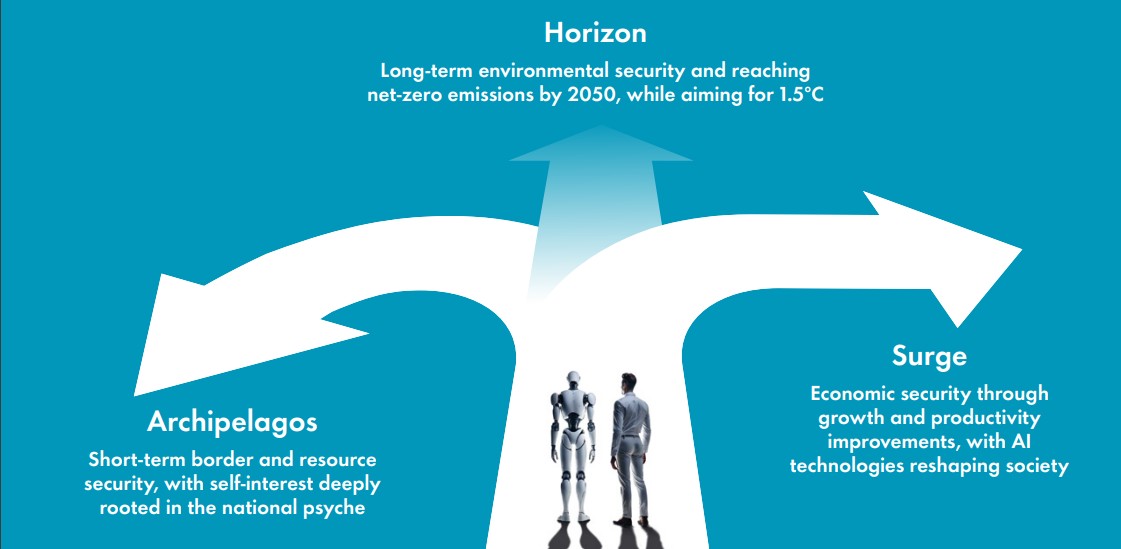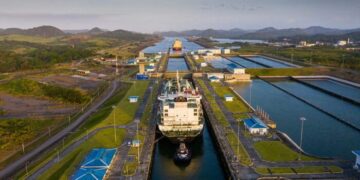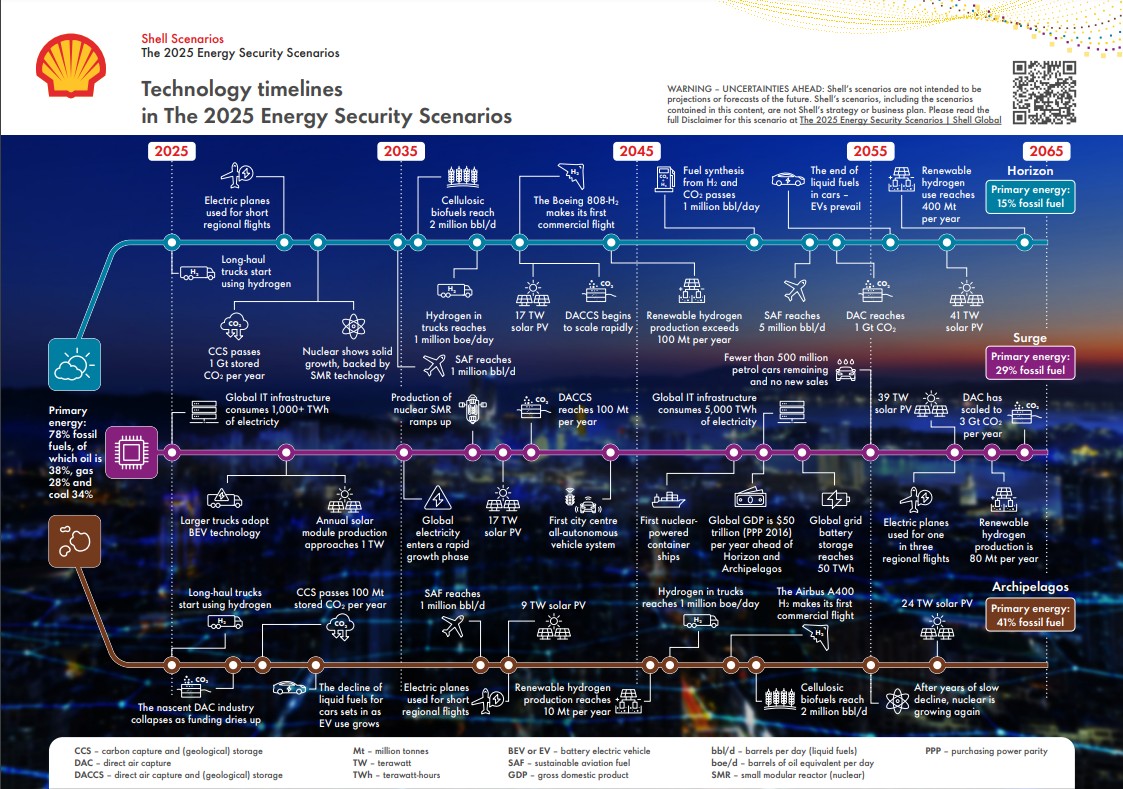The influence of AI is being felt in many areas, but over the next 20 to 30 years, it could bring significant changes to the energy system. Furthermore, Shell notes in a recent report that renewable and nuclear power are expected to decarbonize many energy services through electrification.
In this context, the British energy company has created three different scenarios for modelling energy security in the long term, that serve as an exploration of how the world could possibly evolve under different sets of assumptions.
In a recenty-published report, titled ”The 2025 Energy Security Scenarios: Energy and artificial intelligence” , Shell stresses that the most positive outlook in terms of economic growth is dubbed ‘Surge’ and presupposes a pervasive use of artificial intelligence that would boost productivity globally and drive up the energy demand. A second scenario called ‘Archipelagos’ sees countries around the world focused more on their self-interest than working together to spread the use of AI and develop renewable energy sources. The ‘Horizon’ scenario is instead based on the assumption that the world will reach net-zero CO2 emissions by 2050 and deliver a global average temperature rise below 1.5 degrees Celsius by the end of the century.

To remind, Shell initially published The Energy Security Scenarios in March 2023, at a time when the focus of the world was on high energy prices, with the cost of electricity at record levels in much of Europe.
”Faced with the question of what the rise of AI might mean for the energy system, we again make use of scenario analysis. At Shell, scenario analysis plays a key role in creating context and growing understanding around energy system, technology, geopolitical and social trends.” Shell explains in the report, clarifying that these scenarios do not reflect its strategy or business plan.
The following infographic by Shell spans from 2025 to 2065, detailing the evolution of primary energy sources, technological advancements within the energy system, and significant milestones in various sectors such as transport, energy production, and carbon capture. At the start in 2025, global primary energy use is 78% fossil fuels (oil 38%, gas 28% and coal 34%).
#1 In a world where Artificial Intelligence (AI) brings societal change and catalyses economic growth, demand for energy increases and the transition to a low-carbon energy accelerates
Countries are striving to deliver a new era of economic growth driven by technologies like AI while addressing energy security and climate change.
#2 Growth in demand for energy is driven by rising populiations and prosperity
Over the next 25 years, around a third of the world’s population will embrace higher income lifestyles, such as buying their first cars or taking their first flights. The 2025 Energy Security Scenarios highlight that primary energy demand in 2050 could be nearly 25% higher than in 2024.
#3 Technological change moves faster than energy system change
Historically, it has taken new technologies 15‒25 years to establish themselves in the energy system, then another 15‒25 years to reach system-wide adoption. Information technology adoptions are around twice as fast as new adoptions in the energy system. As a result, as technologies like AI begin to impact the energy system, we can expect increased disruptions.
#4 Oil and gas remain important fuesl for decades to come
Oil demand is likely to grow by 3‒5 million barrels per day into the early 2030s, with a long but slow decline after that as petroleum remains an affordable and convenient fuel, particularly in transport, and an important feedstock for the petrochemical industry.
Natural gas demand could grow by around 500 billion cubic metres per annum (bcma) reaching around 4,640 bcma in 2040, of which 20% is liquefied natural gas (LNG). Gas fuels heat and power generation and has an important role in helping the world move away from coal.
#5 Continued oil and gas investment is needed in all scenarions
Upstream investment is currently around $600 billion a year. This will be required for decades to come as the rate of depletion of oil and gas fields is two to three times the potential future annual declines in demand.
#6 The energy system is increasingly scaling up through modular technologies
Construction of the energy system is shifting from large bespoke projects built in the field to modular units produced on assembly lines, for example solar photovoltaic modules and grid batteries.
#7 Renewable and nuclear power will decarbonize many energy services through electrification
- Solar photovoltaic, wind turbines and batteries come to dominate electricity generation.
- Nuclear could grow in the long term, with the help of new technologies.
- Electrification increases in many sectors, for example through the growth of electric vehicles.
#8 Biofuels, hydrogen, carbon capture and storage (CCS) and carbon removals are required to lower energy system emissions
- Biofuel production could triple by 2050, particularly if advanced conversion technologies progress.
- Hydrogen produced from water using renewable electricity or from natural gas with CCS will also grow, but only for uses where electrification is not an option.
- CCS could be a billion-tonne-a-year industry by 2050.
- Natural and engineered carbon removal will be crucial in the second half of the century.
#9 Peak energy system CO2 emissions is likey within a decade, as illustrated by The 2025 Energy Security Scenarios
Momentum in low-carbon technologies is already slowing growth in emissions. Following current trends, new technologies could halve the carbon intensity (kg CO2 per unit of energy) of the energy system by 2050. However, to reach net-zero CO2 emissions by 2050, progress will have to accelerate considerably.
#10 The 2025 Energy Security Scenarios indicate net-zero CO2 emissions is likely, but timing is uncertain
Plausible scenarios indicate a near-term overshoot of the 1.5°C goal, indeed temperature measurements have already confirmed that 2024 is the first individual year to breach 1.5°C. By focusing on carbon removal technologies and practices, the world could achieve less than ~2°C of warming by the end of the century.
AI and the evolution of the energy system
According to the report, the following could bring significant change:
- Production of modules (such as solar photovoltaic panels, batteries and heat pumps) for the energy system could accelerate as AI improves manufacturing and delivers ever more complex assembly line production of components.
- Autonomous systems are appearing in vehicles. When vehicles begin to operate autonomously on a larger scale within a managed traffic environment, system efficiencies could be considerable, which could spark a more rapid uptake of electric vehicles (EVs).
- A managed EV system allows the battery storage inherent in the vehicles to contribute to electricity grid storage and flexibility requirements, hastening the journey to a renewable-only electricity system.
- As quantum advantage emerges (the point at which a quantum computing system solves problems outside the reach of classical algorithms), advances in materials science, electrochemistry, biotechnology and nuclear engineering could accelerate electrification and energy storage, introduce new sustainable fuel processes and bring safe modular nuclear reactors into a variety of stationary and mobile applications.
- Large energy infrastructure projects could be accelerated as new AI tools are applied to project management
- AI and the supporting data systems will require large-scale uninterruptable power supplies, with overall electricity demand increasing as a result, even as other efficiency gains are made.
- Electricity system management, both in terms of balancing supply and managing demand through smart responses in homes and factories will favour renewable energy systems with grid battery storage. Location-specific solutions are more easily realised as is the use of long-distance power interconnections.


































































